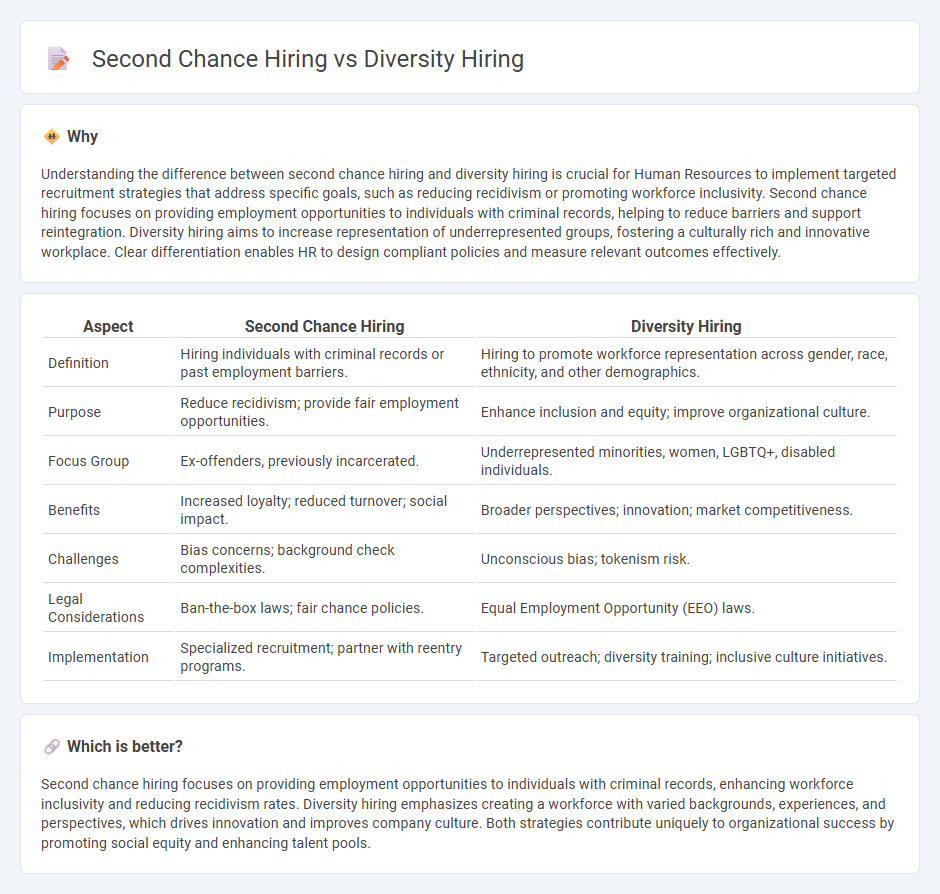
Second chance hiring focuses on recruiting individuals with prior criminal records to provide them opportunities for reintegration and reduce recidivism, while diversity hiring aims to create a workforce inclusive of various backgrounds, ethnicities, and perspectives. Both strategies enhance organizational culture and contribute to broader social equity by addressing different but complementary barriers to employment. Explore how integrating these approaches can transform your HR policies and unlock untapped talent pools.
Why it is important
Understanding the difference between second chance hiring and diversity hiring is crucial for Human Resources to implement targeted recruitment strategies that address specific goals, such as reducing recidivism or promoting workforce inclusivity. Second chance hiring focuses on providing employment opportunities to individuals with criminal records, helping to reduce barriers and support reintegration. Diversity hiring aims to increase representation of underrepresented groups, fostering a culturally rich and innovative workplace. Clear differentiation enables HR to design compliant policies and measure relevant outcomes effectively.
Comparison Table
| Aspect | Second Chance Hiring | Diversity Hiring |
|---|---|---|
| Definition | Hiring individuals with criminal records or past employment barriers. | Hiring to promote workforce representation across gender, race, ethnicity, and other demographics. |
| Purpose | Reduce recidivism; provide fair employment opportunities. | Enhance inclusion and equity; improve organizational culture. |
| Focus Group | Ex-offenders, previously incarcerated. | Underrepresented minorities, women, LGBTQ+, disabled individuals. |
| Benefits | Increased loyalty; reduced turnover; social impact. | Broader perspectives; innovation; market competitiveness. |
| Challenges | Bias concerns; background check complexities. | Unconscious bias; tokenism risk. |
| Legal Considerations | Ban-the-box laws; fair chance policies. | Equal Employment Opportunity (EEO) laws. |
| Implementation | Specialized recruitment; partner with reentry programs. | Targeted outreach; diversity training; inclusive culture initiatives. |
Which is better?
Second chance hiring focuses on providing employment opportunities to individuals with criminal records, enhancing workforce inclusivity and reducing recidivism rates. Diversity hiring emphasizes creating a workforce with varied backgrounds, experiences, and perspectives, which drives innovation and improves company culture. Both strategies contribute uniquely to organizational success by promoting social equity and enhancing talent pools.
Connection
Second chance hiring and diversity hiring both aim to create inclusive workplaces by broadening talent pools beyond traditional criteria. Second chance hiring focuses on individuals with criminal records, while diversity hiring targets underrepresented groups such as minorities, women, and differently-abled people. Integrating these strategies enhances workforce diversity, reduces bias, and promotes equitable employment opportunities.
Key Terms
**Diversity Hiring:**
Diversity hiring prioritizes recruiting candidates from varied demographic backgrounds, including race, gender, ethnicity, and disability, to foster an inclusive workplace that drives innovation and enhances company culture. Companies implementing diversity hiring report improved employee satisfaction, broader perspectives, and better financial performance, as diverse teams outperform homogenous ones by 35%. Explore more about how diversity hiring can transform your organization's recruitment strategy.
Inclusion
Diversity hiring emphasizes recruiting candidates from varied backgrounds to create a more inclusive workforce reflecting different races, genders, and cultures. Second chance hiring targets individuals with past criminal records or employment gaps, promoting social reintegration and reducing stigma. Explore more strategies to enhance inclusion and equity within your organization.
Equal Opportunity
Diversity hiring emphasizes creating a workforce that reflects a wide range of backgrounds, experiences, and perspectives to promote innovation and inclusivity. Second chance hiring targets individuals with criminal records or past barriers to employment, providing them with opportunities for reintegration and reducing recidivism. Explore how both approaches contribute uniquely to equal opportunity and strengthen organizational culture.
Source and External Links
11 Diversity Recruiting Strategies to Upgrade Inclusive Hiring - Diversity hiring best practices involve creating inclusive job descriptions, reaching diverse candidate pools, blind recruitment to reduce bias, diverse hiring teams, unconscious bias training, building diverse partnerships, fostering an inclusive culture, and tracking diversity metrics for accountability.
Diversity hiring 101: A quintessential guide for recruiters - Effective diversity hiring starts with reviewing current recruitment data, focusing on specific diversity goals, and changing sourcing strategies such as writing inclusive job descriptions and targeting diverse candidates.
Benefits of Diversity Hiring & How to Do It - Revelo - Diversity hiring enhances candidate experience, reduces unconscious bias through techniques like blind resumes and diverse interview panels, and brings unique perspectives that improve decision-making and innovation in teams.
 dowidth.com
dowidth.com